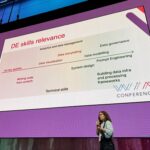Data Cleaning, The Make it or Break it Step to BI Data Analytics
So, your company is planning to use predictive analytics to climb ahead of the market? Smart move.
But before you start to play with those shiny machine learning algorithms, you need to collect and clean up your data.
It’s not everyone’s favorite step…I mean who really likes cleaning? In fact, 60% of data scientists view data preparation and data cleaning as the least enjoyable part of their work.
But data cleaning is vital to effective data analytics.
Looking for a partner to help with your data clean up or data analytics?
Before we dive into the ins and outs of good data cleanup, we have to ask…
What can predictive analytics do for your business?
Powered by machine learning, predictive analytics provides actionable insights. Armed with this knowledge, decisions can drive business growth and grow customer loyalty.
With effective data, an organization can:
- upsell to customers
- predict industry trends
- implement strategies for employee satisfaction
- understand customer feedback
…and much more.
Predictive Analytics in Practice
Have you ever gone to the grocery store, for one thing, a loaf of bread…only to leave $100 later with shopping cart full of food?
It’s not luck that you walk past the peanut butter and jelly from the bread aisle to the checkout. Because of predictive analytics, grocery stores understand consumer buying patterns. By organizing the store based on these patterns, you are more likely to make a spontaneous purchase.
If this causes most customers to buy even one unintended item, this an account for major revenue.
The practice has been in place for years. But with machine learning, companies can be more strategic than ever.
- Streaming services use analytics to recommend new songs or shows you might like.
- Analytics prompts those crazy specific adds that pop up on your social media.
- Predictive analytics even plays cupid, suggesting your matches on online dating apps.
The use-cases are endless. But without clean data, it does not matter how advanced your machine learning algorithms are. Without clean data, predictive analytics is useless.
You Can’t Have Good Analytics without Data Cleaning
Cleaning your data is a crucial step to prepare data for analytics. Did you know data preparation accounts for 80% of a data scientist’s work?
Why? Unnecessary noise in a dataset can lead to the wrong conclusions. So you do not only have inaccurate information but wasted time.
Presenting inaccurate data to upper management will cause them to lose faith in your analytics.
Knowing how powerful good insights can be, we want to make sure we have accurate data to fuel them.
But what constitutes clean data? Clean Data is:
- Accurate
- Complete
- Consistent
- Valid
Let’s explore this idea more with our grocery store example:
Each of your purchases gives stores invaluable data about your buying patterns. That data, combined with data from hundreds of other customers and stores make for some pretty accurate insights.
But…let’s say you have data from two major US-based grocery store chains, Kroger and Publix. Kroger may label a loaf of white bread as whitebread001, while Publix calls it bread-white1.
While us humans understand that these labels refer to similar items, a computer might not.
Of course, you can put a team together to sort through the data. But think of how many people buy bread each year at Kroger’s 2,800 stores or Publix’s 1,200.
That’s a lot of data…and manually sorting through it all is not an effective use of time.
But that is where machine learning comes in. You don’t need to wait until the data is clean to leverage this powerful tool. Engineers can write machine learning algorithms to sort through the data.
Want to know more about preparing your data? We have a post that goes over the ins and outs to a good extract, transform, load (ETL) solution.
Things to Keep in Mind During Data Cleaning:
So, what do you need to do to ensure your data is clean and ready to analyze?
Complete
Fill in missing data
You may find that there are gaps in your data or one dataset includes a variable that another doesn’t. In this case, it is important to fill in any missing information to ensure your data is complete and insights accurate.
Filter out data that you don’t need
Not only will this step make it easier for you to navigate through your data, it saves processing time. In the age of big data–think thousands of terabytes or petabytes–this is vital.
Accurate
Eliminate duplicates
Do not let a record’s sneaky evil twin skew your analytics.
Clean up data
For qualitative data, you will want to remove punctuation, special characters, transform all data to lowercase, etc.
Consistent
Standardize naming
In the example we mentioned earlier, we showed you the issue of different naming formats. For this step, you will want to ensure data that represents the same thing, has the same name.
Organize your data with clean columns
Create clean column names, this will make analyzing data much easier. For example, change columns labeled “Current STATUS,” to “current_status.”
Valid
Rectify outliers
Data visualization is a powerful tool to help you identify outliers. Run basics descriptives (like range, mean, median, and standard deviation) on quantitative datasets. From there you can identify outliers that might skew your analytics.
And there you have it! Take your clean data set and let those machine learning algorithms get to work on those business insights!
If you are working with a microservices architecture, check out this post that explains how microservices handles big data.
Looking for a partner to handle your data clean up or the entire ETL process? KMS engineers are here to help. Learn more about our data analytics offering.






